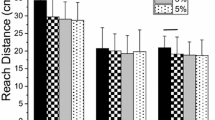Abstract
Anticipatory control of upright posture is the focus of this study that combines experimental and modeling work. Individuals were asked to raise or lower their arms from two initial postures such that the final posture of the arm was at 90° with respect to the body. Holding different weights in the hand varied the magnitude of perturbation to postural stability generated by the arm movement. Whole body kinematics and ground reaction forces were measured. Inverse dynamic analysis was used to determine the internal joint moments at the shoulder, hip, knee and ankle, and reaction forces at the shoulder. Center of mass (COM) of the arm, posture (rest of the body without the arms) and whole body (net COM) were also determined. Changes in joint moment at the hip, knee and ankle revealed a significant effect of the direction of movement. The polarities of the joint moment response were appropriate for joint stabilization. Net COM change showed a systematic effect of the direction of movement even though the arm COM was displaced by the same amount and in the same direction for both arm raising and lowering conditions. In order to determine the effects of the passive forces and moments on the posture COM, the body was modeled as an inverted pendulum. The model was customized for each participant; the relevant model parameters were estimated from data obtained from each trial. The ankle joint stiffness and viscosity were adjusted to ensure postural equilibrium prior to arm movement. Joint reactive forces and moments generated by the arm movements were applied at the shoulder level of this inverted pendulum; these were the only inputs and no active control was included. The posture COM profile from the model simulation was calculated. Results show that simulated posture COM profile and measured posture COM profile are identical for about 200 ms following the onset of arm movement and then they deviate. Therefore, the initial control of COM is passive in nature and the observed joint moment response is for joint stabilization and not for the control of COM.
Similar content being viewed by others
Author information
Authors and Affiliations
Corresponding author
Rights and permissions
About this article
Cite this article
Patla, A.E., Ishac, M.G. & Winter, D.A. Anticipatory control of center of mass and joint stability during voluntary arm movement from a standing posture: interplay between active and passive control. Exp Brain Res 143, 318–327 (2002). https://doi.org/10.1007/s00221-001-0968-6
Received:
Accepted:
Published:
Issue Date:
DOI: https://doi.org/10.1007/s00221-001-0968-6




